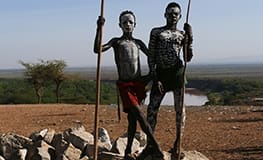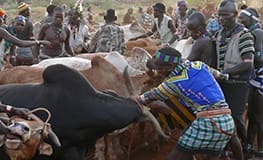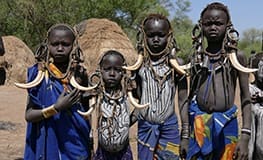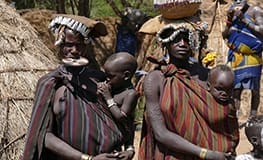Omo Valley
The Omo Valley of southwestern Ethiopia is home to some of the most remote, colorful and interesting cultures in the world. Until the last few decades, these tribes have lived in isolation from the modern world. Some of the different ethnic groups situated along the Omo River include the Karo, Dus, Ngangatom, Hamar, Kwegu and Mursi. The Omo River flows for nearly a thousand kilometers from near Addis Ababa to empty into Kenya’s Lake Turkana.
The Karo mainly practice flood retreat cultivation, as do many of the tribes. When the level of the Omo recedes (September or October), they cultivate the river banks, continuing to do so as the river level continues to drop. Women make clay pots, which they trade with members of other tribes. The Karo are exceptional in the way they paint their face and body for dances and ceremonies. Karo women scarify their chests to beautify themselves; they use a knifte to cut the scars, then rub ash into the wound to produce a raised welt. Their traditional evening dances are exceptional and a thrill.
The Ngangatom tribe is rather war-like, and has settled primarily on the western side of the river. This is a great tribe to visit as they are less visited than most of the tribes on the eastern side of the river. The Hamar is a large agro-pastoralist tribe with a population of around 20,000 members who are known for their practice of body adornment. The women have long braided hair and wear heavy polished iron jewelry around their necks. The Hamar Market in Dimeka is held every Saturday and Tuesday. Hundreds of Hamar traders display their goods including honey, tobacco, sorghum, coffee substitute, gourds, jewelry, bananas, sorghum beer, rust-colored dust used to dye their hair, and much more.
The Hamar's most important ceremony is the “bullah” or “jumping of the bulls.” This occurs when a boy becomes engaged and is about to enter adulthood. Several hundred invited guests witness the ceremony. The “Maz,” or recently initiated men, must take a running leap onto the back of the first bull. Then he runs across the backs of a dozen or so lined up in a row, without falling, back and forth, 4 times. While running, the Maz ritualistically whip his young female cousins and sisters to encourage him. They don’t show the pain they must feel and they say they’re proud of the huge scars that result. Successfully done, he is blessed and sent off with the Maz who shave his head and make him one of their number.
The Mursi possess a war-like culture, predominantly fighting to control large tracts of land for grazing. Many Mursi women have clay plates up to 7 inches in diameter inserted in their lower lips. The men practice light scarification on their shoulders after killing an enemy, and paint most of their bodies with white chalk during dances and ceremonies. They are the most accessible tribe, and therefore more “commercial” than other tribes.
The Suri are relatives of the Mursi and live in the western highlands of the Omo Valley. In terms of logistics, this area is much harder to access and therefore fewer tourists are able to visit. Consequentially, they are more in touch with traditional ways and practices—which includes scarification, lip plates and stick-fighting. For those in search of the quieter corners of the valley, the Surma highlands are a must.
The Kwegu live on banks of the confluence of the Omo and Mago Rivers. Numbering just a few hundred, they are good fishermen and also trap small game and collect honey and wild fruits. These people are the poorest of the poor on the Omo. They have neither cattle nor land.
A bridge across the Omo is allowing for easier access to the tribes on the west bank. Visitors should allow at least 5 days to explore the Omo River Valley.















